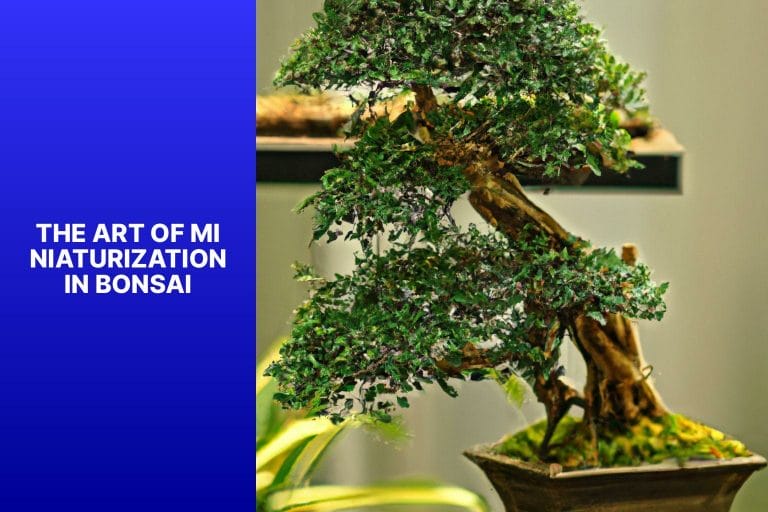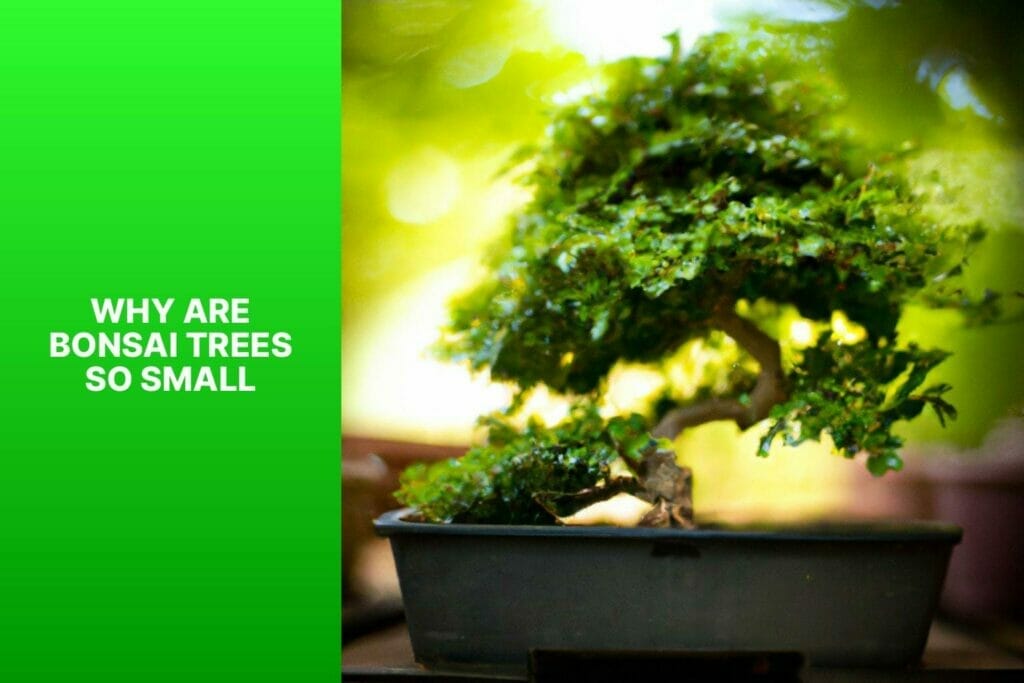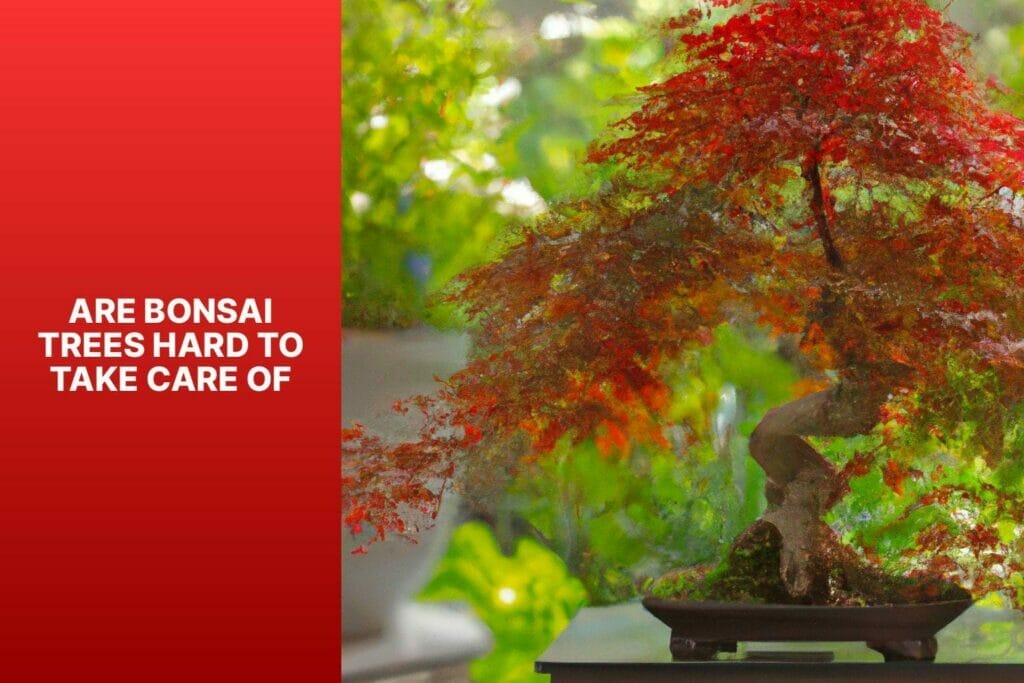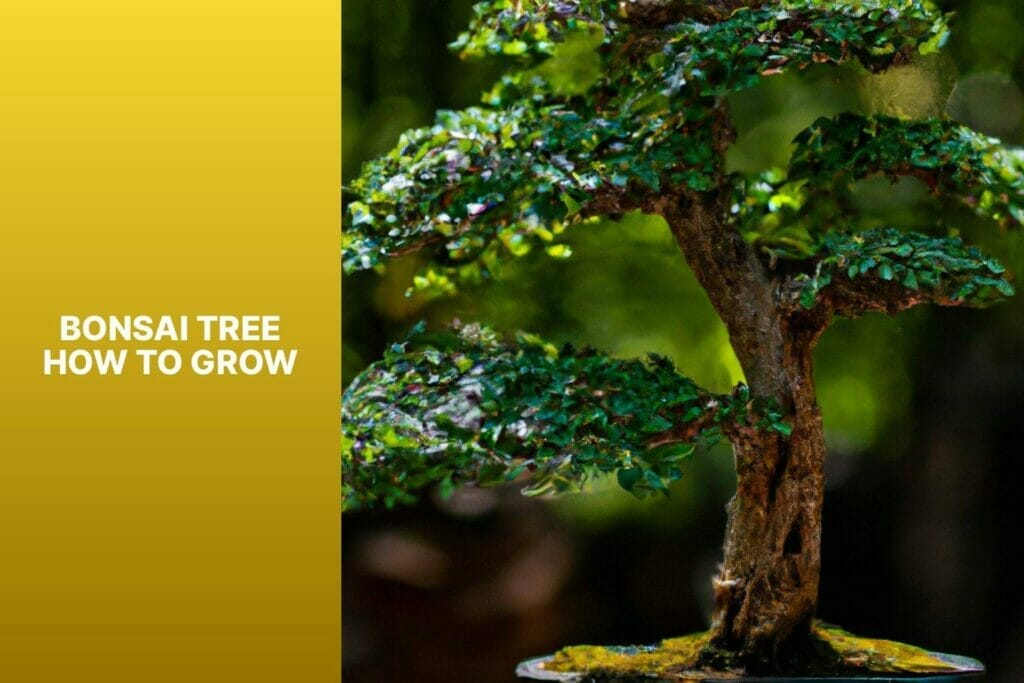Bonsai trees’ enchanting beauty and diminutive size have captured people’s fascination worldwide. The art of growing bonsai trees involves meticulously cultivating and training them to maintain their small, proportionate form.
This article aims to delve into the reasons behind the small size of bonsai trees and the factors that influence their growth.
The concept of miniaturization in bonsai, its cultural significance, and common misconceptions surrounding bonsai size will be explored.
Bonsai trees are not naturally small but are meticulously shaped and pruned to maintain their miniature stature. The art of bonsai combines horticultural techniques, creative design, and a deep understanding of the tree’s natural growth patterns.
Various factors, including bonsai techniques and training, the species and genetics of the tree, and the selection of appropriate containers or pots, influence the size of a bonsai tree.
Intriguingly, miniaturization in bonsai is not solely an aesthetic pursuit but also deeply rooted in Japanese culture. Bonsai trees hold symbolic and spiritual significance and are often associated with longevity, harmony, and balance.
The art of bonsai is seen as a reflection of the larger natural world, encapsulating the beauty and serenity of nature in a miniature form.
It is important to dispel common misconceptions surrounding bonsai and its size. Bonsai trees are not different species; they are regular trees carefully cultivated and trained to maintain a small size.
Pruning, wiring, and other techniques are applied to control the growth and maintain the desired proportions of the tree. Bonsai trees require skilled care and ongoing maintenance to preserve their minute size and aesthetic appeal.
Key takeaway:
- Bonsai trees are small due to various factors such as bonsai techniques, species, genetics, and container selection.
- The art of miniaturization in bonsai reflects Japanese cultural perspectives and holds symbolic and spiritual significance.
- Common misconceptions about bonsai trees and their size include differences from regular trees and techniques like pruning for size control.
What is the Essence of Bonsai Trees?

Photo Credits: Mnbonsainetwork.Com by Vincent Martin
The essence of bonsai trees lies in their ability to capture the spirit of nature in a small, captivating form. Bonsai is achieved through careful cultivation and pruning, resulting in miniature versions of full-sized trees.
These tiny trees showcase the beauty and harmony of nature in a compact form. Bonsai trees require patience and skill to create and maintain, as they must be shaped and nurtured over many years.
Each bonsai tree is unique in its character and style. They reflect the natural world and evoke tranquility and serenity. Through bonsai, we can appreciate the power of nature’s harmony and the beauty achieved through careful cultivation.
So, the essence of bonsai trees lies in their ability to capture the spirit of nature in a small, captivating form.
Factors That Influence the Size of Bonsai Trees

Photo Credits: Mnbonsainetwork.Com by Mason Brown
Understanding the factors that influence their size is key to the fascinating world of bonsai trees. In this section, we’ll dive into the secrets behind the size of bonsai trees.
From the art of bonsai techniques and training to the intriguing role of species and genetics and even the impactful choice of container and pot selection, we’ll unravel the elements that shape the size of these captivating miniature trees.
Get ready to explore the captivating world of bonsai size and its underlying influences.
Bonsai Techniques and Training
These techniques and training are crucial for creating and maintaining beautiful, healthy bonsai trees. By mastering the art of pruning, wiring, repotting, watering, fertilizing, and styling, bonsai enthusiasts can shape their trees into miniature masterpieces.
Understanding and implementing these bonsai techniques and training requires dedication, patience, and a deep appreciation for the art form.
Species and Genetics
One important factor that influences bonsai tree size is the species and genetics of the tree. Each species has its growth habits and potential size, which affects the final bonsai size.
Some tree species naturally have smaller leaves and compact growth patterns, making them ideal for miniature bonsai trees.
For example, species like the Japanese maple (Acer palmatum) and the Chinese elm (Ulmus parvifolia) are commonly used for smaller bonsai trees.
Conversely, species like the juniper (Juniperus) or the pine (Pinus) can create larger bonsai trees with upright growth. Genetics also plays a role in bonsai size, as different varieties or cultivars within a species may have different growth patterns and sizes.
Selecting the right species and considering the genetic characteristics of a tree is crucial for achieving the desired size and shape of a bonsai.
Container and Pot Selection
Container and pot selection is of utmost importance when it comes to the growth and development of bonsai trees. Here are some key factors to take into account:
– Size: It is crucial to choose a container suitable for the size of the bonsai tree, ensuring ample space for the roots to grow.
– Material: Opt for a container that is durable and non-porous, such as ceramic, clay, or plastic. These materials retain moisture and provide good drainage.
– Shape: Consider both the functionality and aesthetic appeal of the container. Traditional options often have rectangular or oval shapes, but round and irregular shapes are also available.
– Depth: The depth of the container plays a role in the tree’s stability and balance. Shallower containers are suitable for young or small bonsai trees, while deeper ones are better for larger, more mature trees.
– Drainage holes: Proper drainage is essential for the bonsai tree’s wellbeing. Ensure the container has enough drainage holes to prevent waterlogging and root rot.
– Color and style: Select a pot that complements the overall aesthetic of the bonsai tree. Consider the pot’s color and style to enhance the miniature tree’s visual impact.
Choosing the right container and pot is essential for bonsai trees’ health, growth, and beauty. When selecting the best container for your bonsai tree, consider its size, material, shape, depth, drainage holes, and aesthetic appeal.
The Art of Miniaturization in Bonsai

Photo Credits: Mnbonsainetwork.Com by Elijah Thomas
Discover the captivating world of miniaturization in the art of bonsai!
Dive deep into the essence of this ancient practice as we explore different perspectives from Japanese culture and unravel the profound symbology and spiritual significance behind these tiny trees.
Prepare to be enchanted as we unveil the secrets and beauty hidden within the delicate art of bonsai, showcasing the exquisite balance between nature and human creativity.
Perspectives from Japanese Culture
Bonsai trees in Japanese culture hold deep significance as living works of art that embody the harmony between man and nature.
Influenced by Japanese aesthetics like wabi-sabi and Zen Buddhism, bonsai trees are appreciated for their tranquility, symbolism, patience, time, and harmonious balance.
1. Tranquility: Bonsai trees create a sense of calm with their carefully pruned branches and miniature size, evoking serenity and peace.
2. Symbolism: Bonsai trees represent nature in their distilled and refined form, symbolizing the cycle of life, change, and the pursuit of perfection. Each bend and curve in the branches carries meaning and reflects the beauty of imperfection.
3. Patience and Time: Cultivating a bonsai tree requires years, sometimes decades, of meticulous care and training. This process teaches patience, appreciation for gradual growth, and the rewards of dedication and perseverance.
4. Harmonious Balance: Japanese culture values harmony and balance in all aspects of life, including bonsai trees. By artfully balancing branches, foliage, and the planting container, bonsai trees create a composition that exudes natural beauty.
Pro-tip: When appreciating bonsai trees from a Japanese cultural perspective, take your time to observe the details and find beauty in simplicity and imperfection. Caring for a bonsai tree can be a calming way to connect with nature and cultivate inner peace, incorporating perspectives from Japanese culture.
Symbology and Spiritual Significance
Symbology and Spiritual Significance play a big role in bonsai art. Bonsai trees hold symbolic meanings in various cultures, especially in Japanese culture.
They represent the natural world in a miniature form, showing the harmony between man and nature.
In Japanese culture, bonsai trees symbolize patience, perseverance, and balance. The care and shaping of the trees represent the Japanese value of discipline and appreciation of simplicity.
Bonsai trees are believed to have a spiritual essence. They are associated with Zen Buddhism, promoting mindfulness and meditation.
Tending to a bonsai tree is viewed as a spiritual practice, cultivating tranquility and harmony.
The size of bonsai trees also has symbolic significance. Their small size represents the vastness of nature within one tree, highlighting the interconnectedness between all living beings and the universe.
Common Misconceptions about Bonsai and Size
Contrary to popular belief, several misconceptions surround bonsai trees and their miniature size. This section debunks these misunderstandings and sheds light on the truth behind bonsai cultivation.
Explore the comparison between bonsai and regular trees, and discover the pruning techniques and size control methods used in this art form. Buckle up and prepare to have your assumptions about bonsai shattered!
Bonsai Trees vs. Regular Trees
| Aspect | Bonsai Trees | Regular Trees |
| Growth | Bonsai trees are pruned, wired, and shaped to stay small. | Regular trees grow naturally to their full size and height. |
| Size | Bonsai trees are intentionally small, with heights ranging from inches to a couple of feet. They suit indoor spaces and small containers. | Depending on the species, regular trees can grow to several feet or even hundreds of feet tall. They require ample space to thrive. |
| Lifespan | Bonsai trees have lifespans similar to regular trees of the same species. With proper care, they can live for decades or even centuries. | Regular trees have longer lifespans than bonsai trees. Some species can live for hundreds or even thousands of years. |
| Aesthetics | Bonsai trees are admired for their artistic appeal and intricate designs, showcasing the skill and creativity of the bonsai artist. | Regular trees have a more natural and wild appearance, contributing to ecological balance and providing shade and animal habitats. |
Pro-tip: Bonsai trees require regular pruning, wiring, and shaping to maintain their small size. Regular trees can grow naturally without intervention.
Choose bonsai trees for artistry and compactness, or use regular trees for a larger and more natural presence in your surroundings.
Pruning and Techniques for Size Control
I once met a bonsai enthusiast who shared his experience with pruning and techniques for size control. He had a Japanese black pine bonsai that had outgrown its designated space.
Instead of giving up on the tree, he meticulously pruned and wired its branches, constantly monitoring its growth. Through his dedicated efforts, he managed to maintain the tree at a manageable size while preserving its natural beauty.
This story emphasizes the importance of proper pruning and size control techniques in maintaining the unique charm of bonsai trees.
Some Facts About Why Bonsai Trees Are So Small:
- ✅ Bonsai trees are intentionally restricted in growth to create a miniature version. (Source: Bonsai Resource Center)
- ✅ Two methods are used to keep bonsai trees small: restraining the growth of the root system and stressing the aerial part through wiring and defoliation. (Source: Bonsai Station)
- ✅ Bonsai trees reflect the Japanese aesthetic and philosophy and are considered works of art. (Source: Science ABC)
- ✅ Bonsai trees are cultivated through pruning and shaping to achieve a desired aesthetic. (Source: Science ABC)
- ✅ Bonsai trees are miniature versions of ordinary trees made through special techniques such as pruning, defoliation, wiring, and potting in shallow pots. (Source: Bonsai Resource Center)


